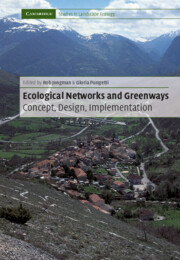Book contents
- Frontmatter
- Contents
- List of contributors
- Foreword
- Preface
- Acknowledgements
- 1 Introduction: ecological networks and greenways
- 2 The context and concept of ecological networks
- 3 Greenways in the USA: theory, trends and prospects
- 4 Ecological functioning of ecological networks: a species perspective
- 5 Impacts of roads on ecological networks and integration of conservation and transportation planning: Florida as a case study
- 6 Ecological corridors on a European scale: a typology and identification of target species
- 7 Planning the future landscape between nature and culture
- 8 From models to reality: design and implementation process
- 9 Design of the Pan-European Ecological Network: a national level attempt
- 10 Ecological ‘black spots’ within the ecological network: an improved design for rural road network amelioration
- 11 An ecological network for the Milan region based on focal species
- 12 Connecting corridors: implementing metropolitan greenway networks in North America
- 13 The Florida Statewide Greenways Project: its realisation and political context
- 14 The ecological network development in the Yungas, Argentina: planning, economic and social aspects
- 15 The river corridor of the Guadiamar
- 16 Conclusions: into the twenty-first century
- References
- Index
Foreword
Published online by Cambridge University Press: 29 December 2009
- Frontmatter
- Contents
- List of contributors
- Foreword
- Preface
- Acknowledgements
- 1 Introduction: ecological networks and greenways
- 2 The context and concept of ecological networks
- 3 Greenways in the USA: theory, trends and prospects
- 4 Ecological functioning of ecological networks: a species perspective
- 5 Impacts of roads on ecological networks and integration of conservation and transportation planning: Florida as a case study
- 6 Ecological corridors on a European scale: a typology and identification of target species
- 7 Planning the future landscape between nature and culture
- 8 From models to reality: design and implementation process
- 9 Design of the Pan-European Ecological Network: a national level attempt
- 10 Ecological ‘black spots’ within the ecological network: an improved design for rural road network amelioration
- 11 An ecological network for the Milan region based on focal species
- 12 Connecting corridors: implementing metropolitan greenway networks in North America
- 13 The Florida Statewide Greenways Project: its realisation and political context
- 14 The ecological network development in the Yungas, Argentina: planning, economic and social aspects
- 15 The river corridor of the Guadiamar
- 16 Conclusions: into the twenty-first century
- References
- Index
Summary
There is an increasing trend towards urbanisation all over the world. In developed countries, around 80% of the human population now lives in cities or towns. Similarly, in developing countries, there is increasing movement to cities and towns with associated development pressures and ecological impacts in urban areas. In addition, while many rural areas are depopulating, changing land uses are placing major ecological pressures on these landscapes. These changes have had major impacts on biodiversity with detrimental changes to ecosystem processes and functions, habitat loss and fragmentation, and widespread loss of species.
Humans are a dominant species; landscape planning and management are necessary to minimise their impacts. In the past, we have relied on dedicated conservation areas and national parks to conserve the biota. We now know that these areas are usually left over after the more productive soils and landscapes have been developed for human enterprises. As a result, these areas are inadequate for the conservation purposes for which they were dedicated. The land outside these areas is also critically important for the conservation of biodiversity, and a layer of management that addresses this function now needs to be added to the more traditional management of much of the world.
Landscape connectivity is one major landscape attribute essential for the conservation of biodiversity. If we are to retain all biotic elements in landscapes and preserve ecological functions, we need to preserve the ecological connectivity of those landscapes. This involved recognising the ecological connectivity of urban and rural landscapes and planning to retain such connectivity or enhance it where appropriate.
- Type
- Chapter
- Information
- Ecological Networks and GreenwaysConcept, Design, Implementation, pp. xv - xviPublisher: Cambridge University PressPrint publication year: 2004
- 1
- Cited by

